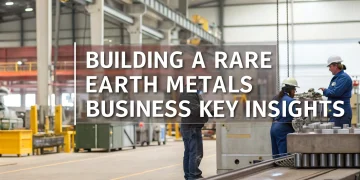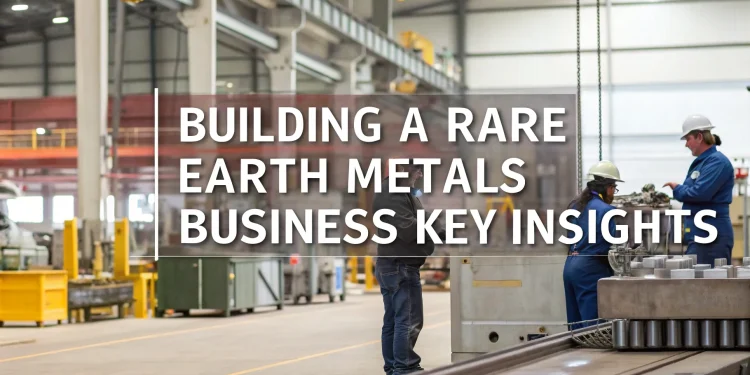What Selects Rare Earth Metals Considered a Strategic Business?
Rare earth elements (REEs) are crucial to modern products and technology, yet tend to go unnoticed by the general public. One can find rare earth metals as neodymium in wind turbine magnets and lanthanum in camera lenses. However, the industry supply of rare earth metals is rather fragile because over eighty percent of the global processing takes place in China. Additionally, constant trade disputes would threaten this dominance.
There exists one clear opportunity for entrepreneurs with this imbalance: addressing national security concerns, technological independence, ESG goals, or simply fulfilling market demand on a global scale. Reread ventures can not only cater to these needs but also ensure sustainable profits at the same time.
Understanding the Rare Earth Value Chain
Prior to starting a business in rare earth materials, it is advisable first understand their complex value chains. The erath value chain starts from raw material extraction, which consists of concentration, separation, refining then alloy production, hiding various ancillary steps like chemical compliance blends and vexing tasks specific to each stage.
For any budding entrepreneur looking forward to opening REE start businesses there exists this broad triage mining-agriculture. Upstream Mining, Midstream Refining Processing Down Stream Finished Goods manufacturing Does raw Materials sourcing offer ground work, building industrial frameworks for different alloy composition techniques while aiding market expectations? Broaden expectation analytics aided via dynamic process computational structures supported flow chart outcomes tailored driven match opportunities make shifts towards immediate draftsno error model representation accuracy provisioning algorithm benchmarks align capabilities maximally mark offsets spanning upward ratios determining shores edge optimal convergence attained geared high outputs pass surpass achievable aligning expectations fully breaking barriers target shifting standards presents elevate impossible leap towards possibilities!!
For Complete Details, Get The Book Here.
Major Industries Boosting Rare Earth Demand
Different firms are slowly but surely increasing the consumption rates of rare earth metals. A good example is the electric vehicle industry which will surpass 230 million units by 2030. It greatly uses neodymium and dysprosium magnets. In addition, rare earths are used in the turbine blades and generators for renewable energy. High-performance alloys are also needed for navigation, targeting, and surveillance in defense systems. At the same time, precision doping with rare earth oxides to improve data transfer speeds and signal clarity is used by telecom and semiconductor companies.
These industries provide mission critical capabilities which allow companies serving these industries to charge more for their services and command stronger business interest.
Critical Initial Processes Needed to Set Up a Rare Earth Business
Every entrepreneur should start any business with timeless research in mind. Potential entrepreneurs should look within their areas for customers, studying regulations around processing them, as well as looking for plentiful sources of rare earth ores. Next comes pilot testing alongside modeling markets before doing comprehensive feasibility studies can be extremely useful getting versatile result outputs that can help one later on down the line.
Despite being hard, gaining permits connected to environmental compliance monitoring are needed for safety’s sake. With many ores of rare earth containing radio actively charged materials, oversight becomes ever more imperative in this regard since there was already added regulatory check points in place put forth by authorities.
Technical Requirements and Infrastructure
Establishing a rare earth business is not only about having vision but also requires the proper technical setup. The processes for rare earth ores are complicated and include solvent extraction, ion exchange, precipitation, and roasting. Specialized equipment like leaching tanks, centrifuges, furnaces, scrubbers, as well as systems for pollution control and environmental monitoring must be used.
In addition to this, end-use industries require extremely high purity levels of over 99.5%, which demands meticulous handling of chemical proportions, temperature gradients, timing cycles, and other factors. The plant’s operational teams should have diverse expertise in chemical engineering as well as metallurgy alongside quality assurance disciplines. The Handbook on Rare Earth Metals & Alloys explains step-by-step guides along with preset workflows and parameter calculations which serve greatly for managers and founders during initial plant setups.
Related: Opportunities in the Ferroalloy Sector
Capital Requirements and ROI Planning
How much does it cost to launch a rare earth business? This is one of the most asked questions entrepreneurs contemplate over.
Due to the differences in entry points, such as mining or refining, expenses may change significantly. From our experience, however, recycling startups tend to start offat around 1 million dollars; additionally, we have observed fully integrated refining plants go upwards of 100 million dollar,s depending on capital investments. Break-even periods in this industry are influenced by numerous factors such as metal pricing, throughput volume, and technological efficiency.
These businesses tend to have high gross margins resulting from the strategic importance of their products. Return on investments can be substantial due to long-term contracts and stable demand from the automotive and defense industries. As described in the handbook, materials yields estimation, refining, operational costs estimation, and other advanced tools increase forecast accuracy for profit scenarios.
Processing & Refining: Profit-Critical Stages
Value creation does not occur at a rare earth mine but rather one step further the processing plant where most of profit is captured during extraction of rare earth oxide elements followed by conversion into high performace alloys or magnets. Purification processes like double solvent extraction or hydrometallurgical purification enhance processes allowing entry into premium markets with higher margin.
Startups that can master these precise techniques are no longer limited to raw materials but also transform them into final components shifting up the value chain. This strategy makes them less vulnerable to swings in commodity prices while offering a greater control over pricing power. The handbooks grant strategic process diagrams and flowcharts accompanied chemical breakdowns enabling refined business strategies that optimize efficiency and achieve planned goals.
Rare Earth Waste Recovery and Sustainability
Sustainability is now mandatory. Governments and sectors are demanding circular solutions, and rare earths are no exception. E-waste recycling, slag processing, and the reprocessing of industrial byproducts are emerging as primary avenues for rare earth recovery.
Startups in this area may benefit from lower capital barriers, quicker setup times, and greener financing. Recycling not only meets environmental requirements but also enhances corporate trust and ESG reputation. The handbook features complete chapters on sustainable sourcing and recovery models that provide a blueprint for sustainable business practices.
Competitive Landscape and Barriers to Entry
While there is a strong need for services, the rare earth sector has does offer some obstacles. Some of these areas include technical complexity, regulatory hurdles, geopolitical risks, Overrides.getDefaulEstablished players take advantage from economies of scale as well as deep integration with OEMs and governments.
With that being said however; nimble startups with niches such as focusing specific metals or new refining techniques or even recycling innovations could catch onto significant market share. The solution is to specialize with patented intellectual property that fortifies alliances during shifts in long-term trends.
Innovation Centers and Emerging Global Dynamics
Japan, Germany, the U.S., and India are all gearing up new innovation centers focused on advanced critical minerals. These collaboration centers bring together academia, industry, and government to sponsor next-gen rare earth research and startup incubation alongside technology transfer.
Startups that set up shop close to these innovation districts reap the benefits of a readily available skilled workforce, access to shared infrastructure, and favorable regulatory conditions. As pointed out in the handbook, many of these initiatives are public-private partnerships that grant funding without equity as well as provide technical mentorship.
Basic Principles on Trade Compliance Regulations and Other Forms of Regulation
One of the most difficult issues to manage with respect to doing business in rare earth is the legal compliance aspect. Compliance with export licensing regulations for waste disposal permits, Compliance With Radioactivity Permits Occupational Health And Safety follows scrutiny. There are international markets which need documents for verification of origin and tracing materials.
If you do not comply with their requirements you will suffer harsh consequences such as banning you from doing business entirely. In order to mitigate these challenges, this book describes compliance frameworks for main jurisdictions -India,-US-the EU along with suggestions on how to uphold transparency, safety, and good regulatory practices.
Using the Handbook for a Streamlined Business Operation
As an entrepreneur serious about the rare earths business, the Handbook on Rare Earth Metals & Alloys serves as an invaluable guide. It goes beyond explaining the science; it turns complicated theories into accessible knowledge.
The book is useful from ore characterization to alloy formulation, and even up to market application. It helps in making critical decisions regarding technology selection, workflow optimization, plant design for scalable operations, comprehensive structure plan drafting, and finalizing investor-ready plans. This is truly a master class of metallurgy and sophisticated industrial business planning.
Grab your copy of the book “Handbook on Rare Earth Metals and Alloys” here
Successful Rare Earth Ventures: A Collection of Distinguishing Case Studies
With smart use of rare earth strategies, several companies have been able to rise from startup status to global relevance MP Materials in the U.S., for example, revived the Mountain Pass mine along with scaling downstream production. In India, private partnerships with IREL resulted in expanded refining and magnet production. REEtec in the EU is building processing facilities that focus on sustainable minimal environmental impact.
These ventures showcase brilliant business-savvy paired with technical know-how. Many owe their success to strong research foundations paired with clear process documentation—principles showcased throughout the handbook.
Strategic Partnerships and Business Growth
To advance in this area, startups need to form alliances. These can include off-take agreements with OEMs, university collaborations for R&D innovation, state agency partnerships for regulatory navigation. In short, collaboration is invaluable.
Joint ventures facilitate capital acquisition, networking opportunities, and fast track learning curves. Market credibility in strategic alliances also supports name recognition which benefits established players. The book describes partnership structuring models along with legal issues and shared R&D collaborations that are advantageous to both novices and seasoned players.
Sustained Growth and Transition Plans
Rare earth businesses are scalable by design. Some will choose to broaden into additional processing sites while others may branch into battery manufacturing or advanced composite materials production. Increased focus from investors makes public listing or acquisition more attainable goals.
The handbook offers templates dealing with business model metamorphosis, risk assessment, and planning for scaling operations remotely or internationally. Founders are now equipped to achieve long-term vision―whether steering towards commanding the market or strategically stepping back through exit.
Revised Final Blueprint
Establishing a rare earth metals business requires unwavering resolve; it requires methodical preparation coupled with deft technical capabilities alongside an understanding of intricate global markets. That said, the emerging financial opportunity is significant alongside strategic positioning advantages.
Using the Handbook on Rare Earth Metals & Alloys allows you to understand not only in a technical sense, but broadens business opportunities as well. It assists with everything from startup ideas to full-scale production and offers extensive insights into the rapidly driving profitable sector.
This is unequivocally the best time to act. Whether you wish to focus on mining, processing, refining, innovating, or recycling them—rare earth metals provide an untrodden avenue for building something of true worth.


























